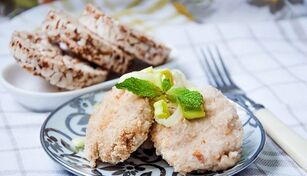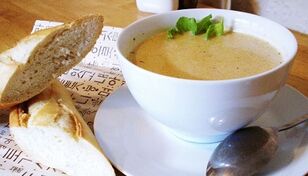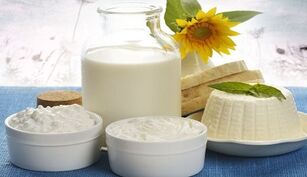
Pancreatitis is a serious pancreatic disease characterized by the destruction of the production of digestive enzymes. The main symptoms of the disease are pain after eating under the left or right cartilage, heartburn, nausea, vomiting and stomach upset.
The key to treating pancreatitis is to strictly follow the dietary guidelines. After all, due to inappropriate lifestyle, heavy use of alcohol and "junk" food often leads to the development of diseases.
Pancreatitis diet can help patients reduce pain during exacerbations and increase remission. In acute and chronic pancreatitis, nutrition is different, but there are still some similarities. Let's talk about them.
General nutritional rules for pancreatitis
The main requirement of the diet is to increase the amount of protein consumed and reduce the fat and carbohydrates in the main diet (if possible, they should be completely eliminated). You should especially give up eating sugar, because it is 99% carbohydrates.
Fat meals with high crude fiber content should completely disappear from the lives of patients with pancreatitis. After all, they put a great load on the pancreas, and as a result, the organs start to produce a large amount of digestive enzymes, which is dangerous for this disease and may cause serious complications.
Doctors recommend that all patients with pancreatitis take vitamin complexes, which will help make up for the lack of vitamins and minerals in the body, which is usually caused by limited nutrition.

Meals should be arranged at the same time.
Eat 5-6 times a day to avoid excessive pressure on the pancreas and overeating.
Acute pancreatitis diet
Usually, acute pancreatitis is manifested by sudden severe pain in the stomach. The pain is unbearable, so people are forced to call an emergency ambulance. Before the doctor arrived, the diet for acute pancreatitis was "zero". Never eat food. Neither "light" nor "heavy".
Before the doctor arrives, you can take non-carbonated mineral water, but no more than 3 glasses. And only allow drinking when the urination process is normal.
The treatment of acute pancreatitis is only performed in the hospital. Fast for the first two days. Only now can I drink rosehip broth with mineral water. The total amount of liquid consumed per day should not exceed 5 cups.
On the third day of treatment, allow the patient to eat fresh, low-calorie food that does not contain substances that can stimulate the pancreas and enhance secretions.
After the main symptoms subsided, the pancreatic pancreatitis diet lasted one to two months. In the meantime, you should give up completely:
- Fried and high-fat foods;
- Muffins and pastries;
- Pickles and smoked food;
- Kimchi and canned food;
- spicy and sweet;
- Onions and garlic;
- Alcoholic beverages;
- Fatty meat and fish;
- Sausage.
All food must be heat-treated. They should be boiled or steamed in water. Do not use oil, salt and spices when cooking.

Patients are only allowed to eat in warm and grated form. Before going to bed, it is recommended to use laxative fermented milk products-kefir, fermented baked milk.
The diet time is 6 to 12 months. The health of people in the future depends on how they persevere. If all nutritional recommendations are ignored, the disease may be in a chronic form, so it must be treated for a lifetime.
Diet to relieve chronic pancreatitis
The chronic pancreatitis diet is slightly different from the above diet. In this case, the patient's diet increased significantly, but only in the remission phase. During the worsening period, the diet has a completely different nature, but later.
In chronic pancreatitis, the intake of protein is allowed, the protein intake should be almost several times a person’s daily intake, and carbohydrates (sugar, honey, baked goods, pastries, etc. ) are also allowed).
Foods that stimulate the pancreas (hot spices, large amounts of salt, alcohol, etc. ) are limited.
The nutrition of the patient should also be fractional. The number of meals is 4 to 6 times. The food served should be warm. There is no need to grind food before eating.
Meat and fish products should not contain large amounts of fat, otherwise it will cause liver degeneration, which often occurs in chronic pancreatitis. Cheese contains many useful substances, so it must simply exist in the patient's diet. However, you can only eat homemade cheese, but not fat. It is forbidden to store cheese.
If a person cannot refuse bread, then it is recommended that he use yesterday's pastries or crackers (only from gray or black bread) when eating. You can also eat baked goods and pastries, but the quantity is limited (up to one serving per day).
If it is pancreatitis, it is recommended not to drink pure milk, because milk is indigestion. It can be added to tea or made into grains and soups. Even if the patient has a good tolerance for milk, he should not drink large amounts of milk. The maximum dose is 200 ml.

Fermented milk products are very useful for people with chronic pancreatitis. Even cheese that has been included in the list of prohibited foods at other stages of the disease can be consumed after relief, but only if you feel good, but not in large quantities. Cheese should not be too salty or fatty.
You cannot eat all eggs. Only egg white can be present in the patient's diet. It can be used to steam egg rolls or add them to soup.
The patient’s diet should not contain too much fat (not more than 70 grams per day). In addition, most of them should be composed of vegetable fats. They are better digested and do not burden the pancreas.
Diet for exacerbating chronic pancreatitis
The diet during the exacerbation of acute pancreatitis is the same as the acute form of the disease. The patient was fasted and allowed to eat small amounts of fresh and low-fat foods when positive dynamic events occurred.If the health condition does not deteriorate, gradually expand the patient's menu. After 2-3 months, the patient can eat in the same way as in the remission phase.
Remember, this is just a crude diet for pancreatitis. The complete list of permitted and prohibited products should be checked with your doctor. Considering your health, only he can constitute the right diet.














































































